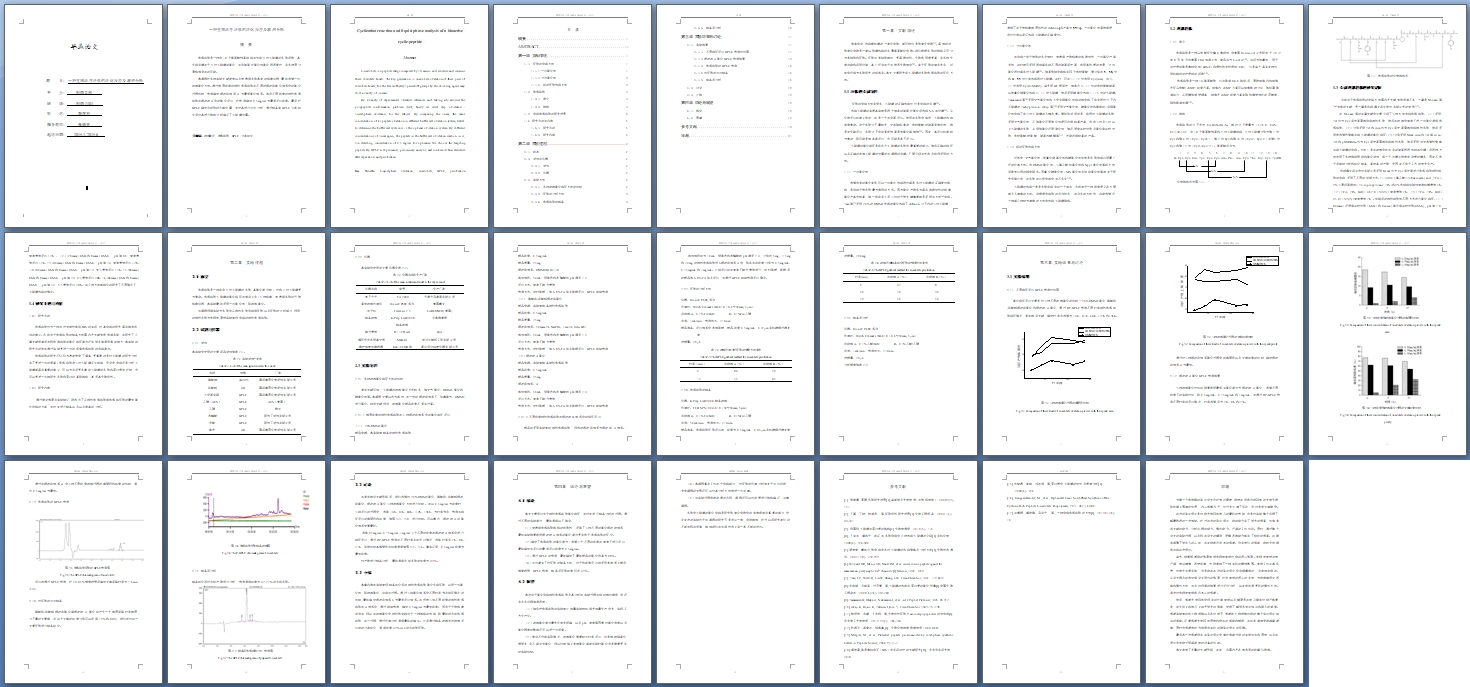一种生物活性环肽的环化反应及液相分析

一种生物活性环肽的环化反应及液相分析(任务书,开题报告,外文翻译,论文7000字)
摘 要
利那洛肽是一种由14个氨基酸残基组成并包含3对二硫键的多肽药物,其生成关键在于3对二硫键的氧化,自由巯基经氧化剂氧化两两配对,有多种同分异构体存在的可能。
本课题经多种实验文献参考以及考虑到多肽本身的构象问题,最终选择一步液相氧化方法。通过相同浓度的线性利那洛肽在不同的缓冲盐氧化体系中的氧化过程比较,检测确定缓冲盐体系A为最适氧化体系。再由不同浓度的线性利那洛肽在缓冲液A中的氧化反应,经检测确定0.5mg/ml为最适反应浓度。最后经HPLC确定目标肽的出峰位置,并对其进行初步分析,通过制备型HPLC分离纯化后对其进行结构分析确证了二硫键位置。
关键词:液相氧化 利那洛肽 HPLC 分离纯化
Cyclization reaction and liquid phase analysis of a bioactive cyclic-peptide
Abstract
Linaclotide is a peptide drugs composed by 14 amino acid residues and contains three disulfide bonds. The key generation is linaclotide oxidation of three pairs of disulfide bonds, for the free sulfhydryl paired off groups by the oxidizing agent may exist a variety of isomers. [版权所有:http://DOC163.com]
By a variety of experimental literature references and taking into account the polypeptide conformation problem itself, finally we select step oxidation - liquid-phase oxidation, for the subject. By comparing the linear, the same concentration of los peptide oxidation in different buffer salt oxidation system, tested to determine the buffer salt system A is the optimal oxidation system. By different concentrations of linear again, the peptide in the buffer salt oxidation reaction in A, via detecting concentration of 0.5 mg/ml for optimum. We choose the targeting peptide By HPLC in experiments, preliminary analysis, and confirm its final structure after separation and purification.
Key Words: Liquid-phase oxidation; linaclotide; HPLC; purification

目 录
摘要 I
ABSTRACT II
第一章 文献综述 1
1.1. 环肽的合成方法 1
1.1.1 一步氧化法 1
1.1.2 分步氧化法 2
1.1.3. 新的环肽形成方法 2
1.2. 利那洛肽 3
1.2.1. 简介 3
1.2.2. 结构 3
1.3. 合成利那洛肽的研究进展 4
1.4. 研究目的与内容 5
1.4.1. 研究目的 5
1.4.2. 研究内容 5
第二章 实验过程 7
2.1. 前言 7
2.2. 试剂与仪器 7
2.2.1. 试剂 7
2.2.2. 仪器 7
2.3. 实验方法 7
2.3.1. 多种液相氧化成环方法的比较 7
2.3.2. 环肽的分析方法 9
2.3.4. 利那洛肽的制备 9
2.3.5. 制备后分析 10
第三章 实验结果与讨论 11
3.1. 实验结果 11
3.1.1. 不同成环反应HPLC检测对比图 11
3.1.2 缓冲液A氧化HPLC检测结果 12
3.1.3. 利那洛肽的HPLC检测 14
3.1.4 对环肽的初步制备 14
3.1.5. 制备后分析 15
3.2. 讨论 16
3.3. 小结 16
第四章 结论与展望 16
4.1. 结论 16
4.2. 展望 17
参考文献 19
致谢 21 [资料来源:www.doc163.com]
